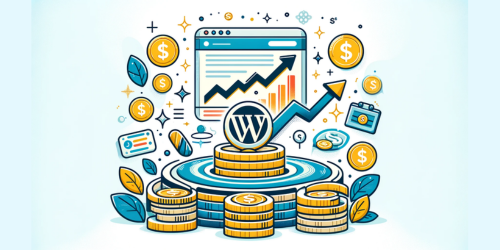Have you ever marveled at the chameleon’s ability to adapt its appearance to its surroundings? Similarly, WordPress, the world’s leading Content Management System (CMS), exhibits a remarkable duality in the realm of web development. It adeptly morphs into both static and dynamic websites, catering to a diverse range of digital landscapes. This article illuminates this dual nature of WordPress, unraveling how it seamlessly transitions between the static serenity and the dynamic vibrancy of web design.
In the forthcoming sections, we will unravel the essence of static or dynamic websites, weigh their pros and cons in the WordPress context, and guide you through real-world scenarios to choose the right approach for your web endeavors. Join me on this insightful journey to understand WordPress’s multifaceted personality, a trait that elevates it beyond a mere web-building tool to a versatile architect of digital experiences.
Key Takeaways:
- WordPress can be either static or dynamic, with dynamic being its inherent nature.
- Static sites have pre-built, unchanging content, suitable for simple, small-scale websites.
- Dynamic WordPress sites offer real-time content updates and complex functionalities.
1. Understanding Static Websites
Static websites are the digital equivalent of a brochure. They’re straightforward, immutable once published, and devoid of real-time interactions. Predominantly crafted using HTML, CSS, and sometimes JavaScript, these websites exhibit a set of fixed content, with each page essentially being a separate document. The absence of a database or server-side processing means what you create is what every visitor sees, unchanged. Think of static sites as reliable, unchanging landmarks in the rapidly evolving digital terrain.
Ideal Use Cases:
- Portfolio Sites: Perfect for showcasing work where updates are infrequent.
- Landing Pages: Ideal for specific campaigns where information remains constant.
- Digital Resumes: A great way to have a permanent online presence with set details about professional achievements.
2. Exploring Dynamic Websites
Contrasting static sites, dynamic websites are like living organisms in the digital ecosystem. They evolve in real-time, responding to user interactions, and are powered by server-side languages like PHP, and databases like MySQL. This architecture allows for personalized experiences, such as user profiles, comments, and real-time updates. Dynamic websites are not just about displaying information; they’re about interaction and personalization.
Where Dynamic Websites Shine:
- E-commerce Platforms: Tailoring user experiences with personalized product recommendations.
- Blogs and News Sites: Regularly updated content keeps these sites fresh and relevant.
- Forums and Social Networks: User-generated content and interactions form the core of these dynamic platforms.
To delve deeper into dynamic web development, Wppedia: Making A dynamic WordPress site is an invaluable resource.
3. Comparative Analysis: Static vs. Dynamic in WordPress
In the WordPress universe, the static vs. dynamic debate takes an interesting turn. WordPress, inherently dynamic with its PHP and SQL backbone, is often perceived as a tool for building vibrant, interactive sites. However, its versatility allows for the creation of static sites too, offering a best-of-both-worlds scenario.
Key Differences:
- Content Updates: Static sites in WordPress require manual HTML updates, while dynamic sites benefit from WordPress’s CMS capabilities.
- Interactivity: Dynamic sites offer user engagement features like comments and forms, which static sites lack.
- Flexibility: WordPress themes and plugins expand dynamic site functionalities far beyond what static sites can offer.
Security Aspects:
- Static Sites: Generally safer due to the absence of database interactions, making them less prone to cyber threats like SQL injections.
- Dynamic Sites: Potentially more vulnerable but can be fortified with the right security measures.
To understand these aspects in a WordPress context, WordPress Static Vs Dynamic Sites provides practical insights.
4. Pros and Cons: WordPress Static vs. Dynamic Sites
In the WordPress arena, choosing between static and dynamic sites depends on specific needs and constraints. Here’s a quick rundown of their pros and cons:
Static WordPress Sites:
- Pros:
- Simplicity: Easier to develop and deploy.
- Performance: Faster load times due to minimal server-side processing.
- Security: Reduced risk of vulnerabilities without database reliance.
- Cons:
- Limited Interactivity: No user-specific content or real-time updates.
- Manual Updates: Content changes require direct HTML coding.
- Scalability Issues: Not ideal for content-rich or frequently updated sites.
Dynamic WordPress Sites:
- Pros:
- Content Management: Easy updates via the WordPress dashboard.
- Interactivity: Supports user engagement and personalized content.
- Functionality: Ideal for complex sites like e-commerce or forums.
- Cons:
- Performance: Potentially slower due to more server resources.
- Complexity: More challenging to develop and maintain.
- Security Risks: Greater exposure to vulnerabilities.
5. Case Studies: When to Choose Static or Dynamic WordPress
Selecting between static and dynamic WordPress sites can be contextual. Here are some real-world examples:
Static WordPress Sites:
- Portfolio Site for an Artist: A static site perfectly showcases their artwork without the need for frequent updates or user interactions.
- Event Announcement Page: For one-off events, a static page suffices to convey all necessary information effectively.
Dynamic WordPress Sites:
- Online Store: A dynamic site is essential for managing inventory, user profiles, and personalized shopping experiences.
- Educational Blog: Dynamic functionality allows for regular content updates, user comments, and interactive learning tools.
Each case underscores the importance of aligning website functionality with its intended purpose and audience needs.
For more case studies, WordPress.org showcases various websites built with WordPress, highlighting their diverse capabilities.
6. Dynamic Content in WordPress: A Closer Look
Dynamic content in WordPress is the driving force behind its ability to offer tailor-made experiences. It’s content that adapts and responds to user interactions or preferences. From personalized greetings to updated blog feeds, dynamic content keeps websites engaging and relevant.
This functionality is especially crucial for sites requiring user input or data-driven displays, like e-commerce platforms or member-only portals. By leveraging WordPress’s dynamic nature, site owners can offer a more engaging and responsive user experience.
To understand the workings of dynamic content in WordPress, WPPedia’s guide provides a comprehensive look at its implementation and benefits.
7. Conclusion: Embracing WordPress’s Flexibility
In the digital landscape, WordPress stands as a testament to versatility, adeptly accommodating both static and dynamic website needs. Its ability to adapt, much like a skilled artisan, enables it to sculpt web experiences that range from the steadfastness of static sites to the fluidity of dynamic environments. This adaptability empowers creators, businesses, and individuals alike to tailor their online presence precisely to their vision and audience needs.
Embracing this flexibility of WordPress is akin to unlocking a toolbox brimming with possibilities, each tool ready to construct a unique corner of the web. Explore, experiment, and exploit the full potential of WordPress to craft your digital masterpiece.
8. FAQ Section
Q: Can WordPress be static?
Yes, WordPress can be used to create static websites. While it’s known for dynamic content, WordPress also allows the creation of static pages without interactive or regularly changing content.
Q: Are WordPress pages dynamic?
WordPress pages can be dynamic. With the right themes and plugins, WordPress pages can display content that changes based on user interactions, preferences, or other dynamic criteria.
Q: Is WordPress a static site generator?
No, WordPress is not primarily a static site generator. It is a content management system (CMS) designed for creating dynamic websites. However, it can be configured to create static pages as part of a dynamic site.
Q: How do I know if my website is static or dynamic?
A website is static if its content doesn’t change unless manually updated by the webmaster. A dynamic website changes content automatically based on user interaction, data input, or other criteria. If your site has features like user accounts, forms, or content that updates in real-time, it’s likely dynamic.



